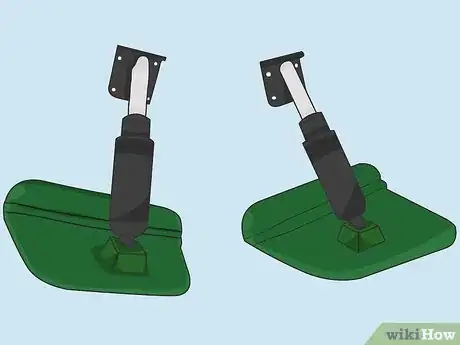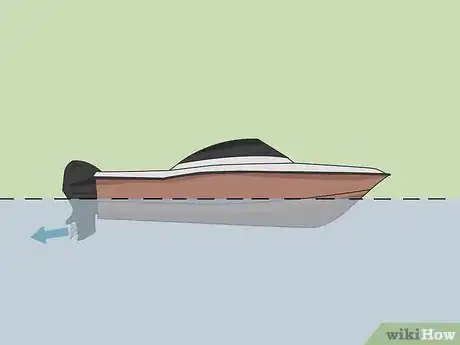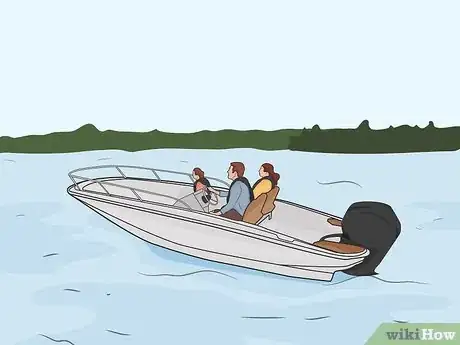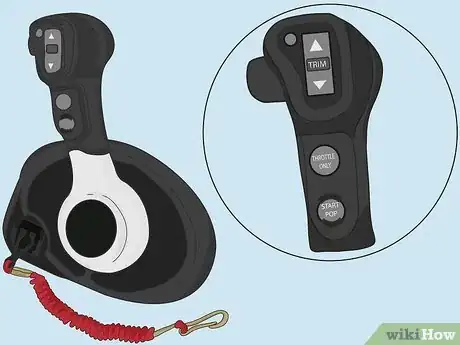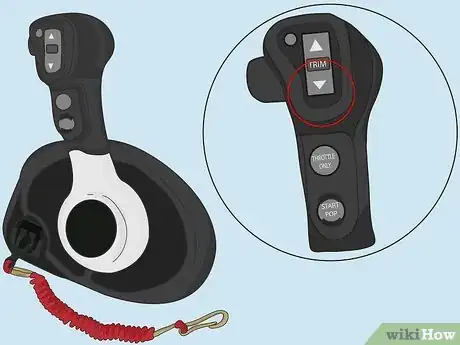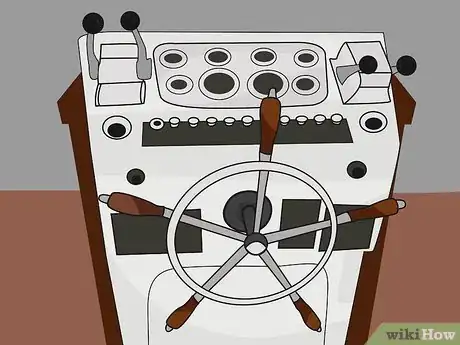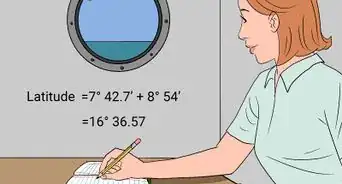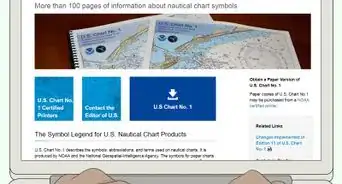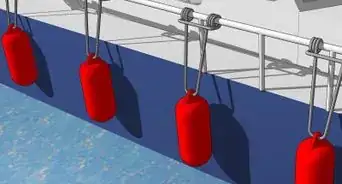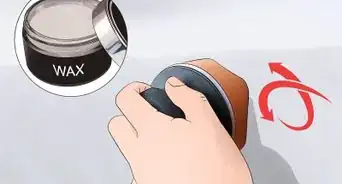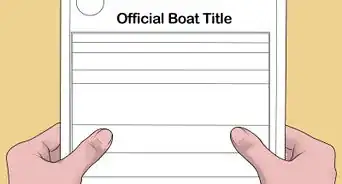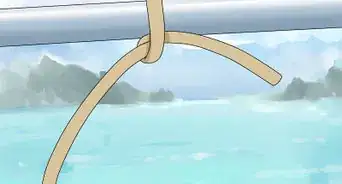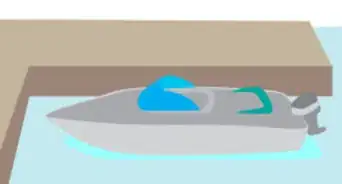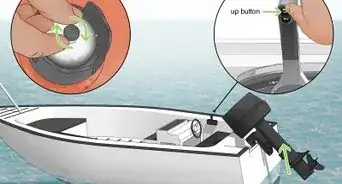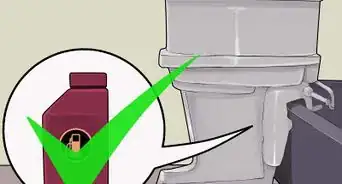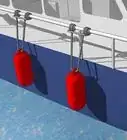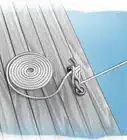This article was co-authored by wikiHow staff writer, Eric McClure. Eric McClure is an editing fellow at wikiHow where he has been editing, researching, and creating content since 2019. A former educator and poet, his work has appeared in Carcinogenic Poetry, Shot Glass Journal, Prairie Margins, and The Rusty Nail. His digital chapbook, The Internet, was also published in TL;DR Magazine. He was the winner of the Paul Carroll award for outstanding achievement in creative writing in 2014, and he was a featured reader at the Poetry Foundation’s Open Door Reading Series in 2015. Eric holds a BA in English from the University of Illinois at Chicago, and an MEd in secondary education from DePaul University.
There are 12 references cited in this article, which can be found at the bottom of the page.
This article has been viewed 12,338 times.
Learn more...
In boating, trim is the general term for the angle of the boat as it sits in the water when you accelerate. If the front of the boat, called the bow, is too high, you won’t be able to control the boat in the water. If the bow is too low, your gas mileage suffers and you won’t be able to accelerate very well. This is where trim tabs come in. Trim tabs are optional fins that rest on the back of boats with outboard motors to adjust the angle of the bow while you accelerate. Keep in mind, if you do not have power trim tabs, you can still manipulate the angle of the bow the same way by adjusting the motor and stabilizing trim.
Steps
Changing Power Trim Settings
-
1Locate the power trim tab controls near the front of your boat. On a boat with power trim tabs, all of the trim tab controls are found in one place. Look for a small digital screen or set of 4 buttons with the word “bow” printed on or next to them. This panel is always located on the helm’s dashboard, but the exact location is different on every boat. Consult your instruction manual if you can’t spot them right away.[1]
- On some boats, there are 2 levers that go up or down instead of 4 buttons.
- Power trim tabs are often found on newer and higher-end boats, but you can have them installed on any boat.
-
2Take your boat out on the water and accelerate to see how it handles. Undock the boat and take it out on the water. Accelerate, turn right, and turn left. Pay attention to how the boat is handling to determine if it’s plane or not. If the ride is smooth when you accelerate and turning is balanced, you don’t need to adjust the trim tabs. If the boat feels like it’s tilted or listed, pay attention to the angle to make adjustments to the trim tabs.[2]
- A boat is plane when the bow (front) of the boat rests at an angle where it glides over the water. Unless you’re dealing with extremely choppy or calm waters, the main goal with the trim tabs is to make the boat plane.
- Trim tabs don’t do anything when you’re in idle or resting in the water. You need to get up to speed to see how the boat handles before making trim tab adjustments.
- Once you understand the trim tab controls, you can adjust them every time you hit the water to customize the way your boat handles based on the conditions.
Advertisement -
3Adjust the bow down if the helm feels like it’s tilted too high. If the front of your boat tilts up when you accelerate straight, keep the boat at a consistent speed and press both “bow” buttons down at the same time. Continue pressing them down until the front of the boat tilts forward and you reach plane. You know you’re plane when the boat feels like it’s gliding over the water.[3]
- Press and release both buttons for the same period of time. You can cause problems for the angle of the boat if you only press one of the buttons while your boat is level.
- Pressing the “bow” down will cause the trim tabs to raise up and pull water up behind the back of the boat. This causes the boat to pitch forward.
- If the bow tilts too far up, you can’t see in front of you. It will also make it harder to handle the boat when the water is choppy or it’s windy out, since a higher percentage of the hull will be sticking out of the water.
-
4Move the bow up if you’re tilted forward or you want to increase speed. If the boat bounces a little when you accelerate or it feels like the bow is digging down into the water, press both “bow” buttons up at the same time. Continue shifting the boat up until you reach plane and release the buttons at the same time.[4]
- This lowers the trim tabs and decreases drag a little. This will cause the back of the boat to push forward and raise the angle as you accelerate.
- If the boat tilts too far forward, it will bounce up and down as the front of the hull keeps punching through the water.
- If the bow tilts too far down, a larger percentage of the hull touches the water. This will harm your gas mileage and make it hard to turn the boat when you’re accelerating.
-
5Adjust the starboard or port sides separately if the boat is listing. If you aren’t plane or you have visitors on your boat shifting the weight, your boat may list to the port (left) or starboard (right) side. If this is the case, move one side of the bow up or down depending on which side is listing. Keep moving the left or right side buttons up or down until you make the boat level and you feel like you’re standing perpendicular to the water.[5]
- If you’re by yourself and the boat feels level, only press the buttons at the same time. Messing with the vertical angle of the boat triggers handling issues if the weight is already even.
Fixing a Listing Boat:
Move the port-side bow up if your boat is tilted forward to the left.
Move the port-side bow down if the boat is listing backwards the left.
Move the starboard-side bow up if the boat is tilted forward to the right.
Move the starboard-side bow down if the boat is listing back to the left.
Adjusting the Motor and Stabilizing Trim
-
1Find the buttons on your control grip to adjust the motor trim vertically. In the driver’s seat, look on the side of your control grip handle for 2 buttons that point up and down. These adjust the trim of the motor and move it up or down. With this style of trim, you can manipulate the angle of the boat by moving the motor.[6]
- The motor trim isn’t technically a trim tab. However, your manual may refer to it as a trim tab since it performs the same basic function.
Tip: On older and lower-end boats, the trim is divided between two separate sets of controls. Power trim tabs typically rely on hydraulic fluid lines that are controlled from one location, but these old school boats use separate electrical lines to change the angle.
-
2Trim the motor up to lower the angle of the bow and improve control. Press the higher button on the control grip to move the motor up and shift the boat forward. This will push the boat down into the water and make it easier to see and control your boat, although you’ll give up some speed and gas mileage.[7]
- This can be kind of confusing since the “up” button moves you down and the “down” button moves you up. You’ll get used to this over time.
- This is generally a good move if the water is choppy or you’re struggling to control the boat when you turn. By pushing the bow forward, you stabilize the boat against the surface of the water. This makes it much easier to steer and you’ll decrease any rocking you’re experiencing from choppy waves.
-
3Shift the motor down to raise the angle of the boat and reduce drag. Press on the lower button on the side of the control grip to lower the motor. This will raise your bow by shifting the angle of your motor forward and pushing the boat up from the water. This is a great option if you’re moving at a consistent pace on calmer water and want to improve your gas mileage and speed.[8]
- When you move the bow forward, you reduce the percentage of the hull that is dragging in the water. This increases your speed, but you give up a little bit of control by doing this.
-
4Rotate the dial on the helm to adjust a stabilizing trim tab. If you have a small rotating dial on the dashboard near the helm, this is your stabilizing trim tab and it controls the list of the boat. This is extremely simple: turn the dial to the right to shift the boat to the starboard side and turn the dial to the left to shift the boat to port size. You only need to toy with this dial if you have an uneven weight distribution and you’re struggling to get plane.[9]
- A boat is plane when it feels like you’re gliding over the water. This only happens when the bottom of the boat rests evenly against the water at a slight upward angle. If the boat is listing, you can’t get plane.
- If there is a screw on top of this tab, turn it 1-2 times with a screwdriver to unlock the tab. Retighten the screw once you get the boat level.
- Like the motor trim, this is technically not a trim tab but it performs the same basic function.
- Some boats have power trim controls for the tabs on the side and one of these dials for the trims on the motor. If your boat has both, never use the dial to adjust the list of the boat. Only use the power trim tabs since they’re easier to adjust on the fly.
Warnings
- Unfortunately, you cannot install trim tabs yourself unless you really know what you’re doing. Installing trim tabs involves running hydraulic lines through your boat, messing with your boat’s electrical components, and drilling into the hull. If you don’t get a professional to do it, it may cost thousands of dollars in damages and you may run into danger on the water.[12]⧼thumbs_response⧽
References
- ↑ https://youtu.be/oLPWdyByy9g?t=44
- ↑ https://youtu.be/oLPWdyByy9g?t=98
- ↑ https://youtu.be/oLPWdyByy9g?t=52
- ↑ https://youtu.be/oLPWdyByy9g?t=67
- ↑ https://youtu.be/oLPWdyByy9g?t=141
- ↑ https://youtu.be/FxSIhhXE1Aw?t=21
- ↑ https://youtu.be/FxSIhhXE1Aw?t=58
- ↑ https://youtu.be/FxSIhhXE1Aw?t=66
- ↑ https://www.colby.edu/chemistry/Colby%20Compass/Yamaha%20Motor.pdf
